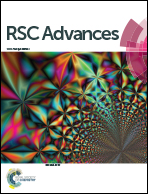CdS sensitized TiO2 photoanodes for quantum dot-sensitized solar cells by hydrothermal assisted chemical bath deposition and post-annealing treatment†
Abstract
A hydrothermal assisted chemical bath deposition method (HACBD) was proposed to directly deposit CdS quantum dots (QDs) on TiO2 photoanodes in quantum dot-sensitized solar cells (QDSCs) for the first time. This method allows a facile and rapid growth and integration between CdS QDs and TiO2 photoanodes, with much lower cost compared to traditional chemical bath deposition (CBD). The post-annealing temperature was found to be crucial for the final performance of the QDSCs. After an appropriate annealing treatment, the conversion efficiency was enhanced from 1.52% to 1.78% under AM 1.5 illumination of 100 mW cm−2, which is attributed to the red shift of the absorption edge of CdS QDs and lower electron recombination rate at the photoanode/electrolyte interface.


 Please wait while we load your content...
Please wait while we load your content...